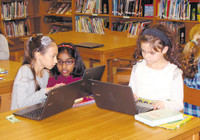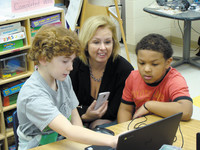Warwick students joined more than 100 million students from more than 180 countries in the Hour of Code, an hour-long coding tutorial teaching students the basics in computer programming through easy …
This item is available in full to subscribers.
We have recently launched a new and improved website. To continue reading, you will need to either log into your subscriber account, or purchase a new subscription.
If you are a current print subscriber, you can set up a free website account by clicking here.
Otherwise, click here to view your options for subscribing.
Please log in to continue |
|


Warwick students joined more than 100 million students from more than 180 countries in the Hour of Code, an hour-long coding tutorial teaching students the basics in computer programming through easy to learn and fun online games.
Hour of Code is a global initiative started in 2013 by Code.org, a non-profit striving to expand participation in computer science, making tutorials and programs available for free online for educators. Last week was Computer Science Education Week, and Code.org’s goal was to have millions of students become exposed to coding in hopes that one day their interest in computer science can lead to a career.
According to Code.org, there are more than 600,000 computer science careers available in this country, but only about 38,000 computer science graduates entered the work force this year.
Although many schools in the district did something the week prior or following, Cedar Hill and Hoxsie had schoolwide initiatives last week. Their students not only participated in the Hour of Code but also did various other computer science activities throughout the week.
This is the third year Cedar Hill has participated in the Hour of Code, and all the classes work on the program during their time at the library. Older and younger students were paired together as “coding buddies” throughout the week, working together to pass all the available levels.
Principal Dr. Colleen Mercurio said that the younger student are engaged in “all things technology” and have a “natural aptitude” for coding, where the older students excel in leadership and bringing them together just made sense.
Kathy Naughton, the school’s librarian, and Kerri Amerantes, a fourth grade teacher, both agreed that students have a knack for computer science and just soak up everything that is presented to them.
Naughton said skills they are learning now could lead to well-paying jobs in the future for these students. She finds that Hour of Code is highly motivational and a “proactive” way to get kids prepared for the workforce in a fun way.
“Students will dabble in and some will find they have an affinity for it, and that’s great. There is a shortage of Americans to fill these types of jobs, and these kids will be career-ready,” Naughton said.
Amerantes pointed out that students are learning more skills than just coding, but also step by step planning, listening to directions and problem solving.
“It’s exciting to see how interested they are,” Amerantes said. “There are so many more opportunities available to them with these skills.”
Cedar Hill has a competitor’s board, encouraging students to see how many lines of code they could create. They topped it at 5,000, but the kids have become so invested they moved past all expectations. One student, William McLelland, a 5th grader, is the “Star Coder” for Cedar Hill with more than 10,000 lines of code in a week.
“Programs like these change culture, they change the world,” Mercurio said. “They are gender neutral and it’s a complete new kind of literacy. It’s just positive all around. This initiative has really permeated the whole building since we first began. A computer is just a tool. It’s not replacing instruction; for this to be successful you still need phenomenal teachers.”
Superintendent Philip Thornton, Lynn Dambruch, Director of Elementary Education and Holly Walsh from the Rhode Island Department of Education (RIDE) all visited Hoxsie on Friday morning, visiting classrooms of all different grades to see how the various ways in which students were coding. Hoxsie also paired older and younger students together and called them “tech buddies.”
This is the first year in which first grade teacher Meredith Andreozzi has participated in the Hour of Code and was initially a little skeptical about bringing it to first grade. Once she saw how quickly her students took to it and the benefits she was seeing in her classroom, she became very excited about the movement.
“This is more than just computer science,” she said, “students are developing more important character traits from this program. This really improves their problem solving skills, collaboration and perseverance.”
Andreozzi found that when her students get frustrated with a certain level seeing other kids succeed it motivating and they will reach out to help and more than happy to provide that support for one another. Because students live in a digital world teaching them digitally just makes sense. She said that coding is almost contagious and over the past few years it has just kept growing throughout the district.
“Students are building confidence in every other area, because if you can code a computer why can’t you learn how to use capital letters properly,” Andreozzi said.
Dambruch said the benefit of these digital programs can be seen by just watching how the students work with one another and the conversations they are having.
“Students are just yearning for the opportunity to learn and excel,” she said. “It integrates all parts of the curriculum and just enhances the classroom.”
The success seen during the Hour of Code initiative in Warwick encourages Thornton further in his priority to see the district go one to one with Chromebooks. He said blended learning is revolutionizing the way we teach and learn and has helped to see more collaboration throughout the system.
He said in any profession it’s necessary to have a basic level of computer skills and programs like the Hour of Code giving Warwick students a “leg up on the competition.”
“Students are picking up this type of learning seamlessly. You can just watch them go,” Thornton said. “To see students working and learning with other students in this way is really powerful.”
“This is the type of work that gives me teacher goose-bumps,” Walsh said.
She finds Hour of Code “extremely important” and brings students to a higher level of learning and collaboration.
“There has been a shift in this state and we are seeing more and more technology in the classroom,” Walsh said. “There is such an excited energy about this and kids are given the tools to do what they do best.”
For more information on the Hour of Code or to try one of their beginner tutorials for yourself visit www.code.org.
Comments
No comments on this item Please log in to comment by clicking here